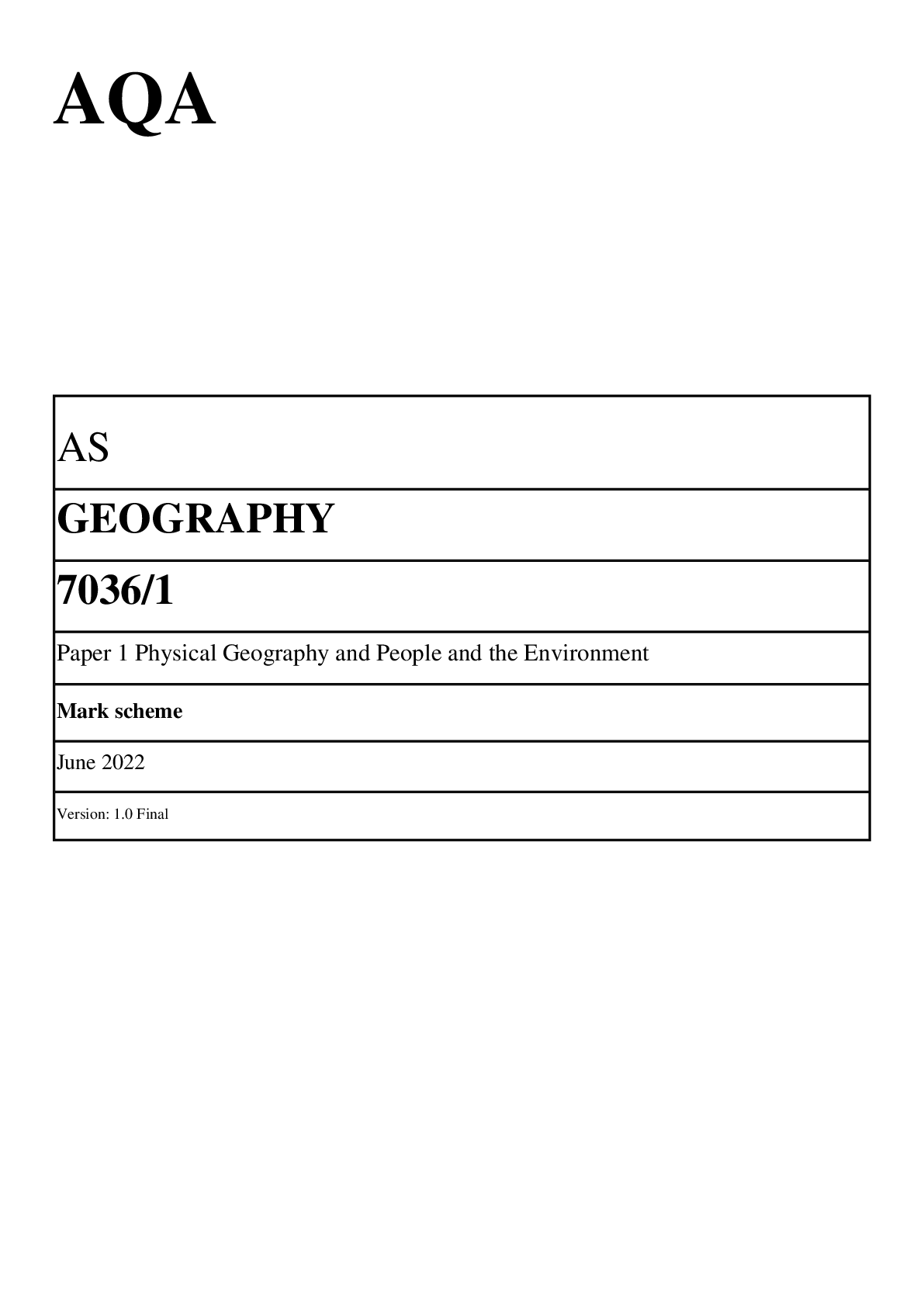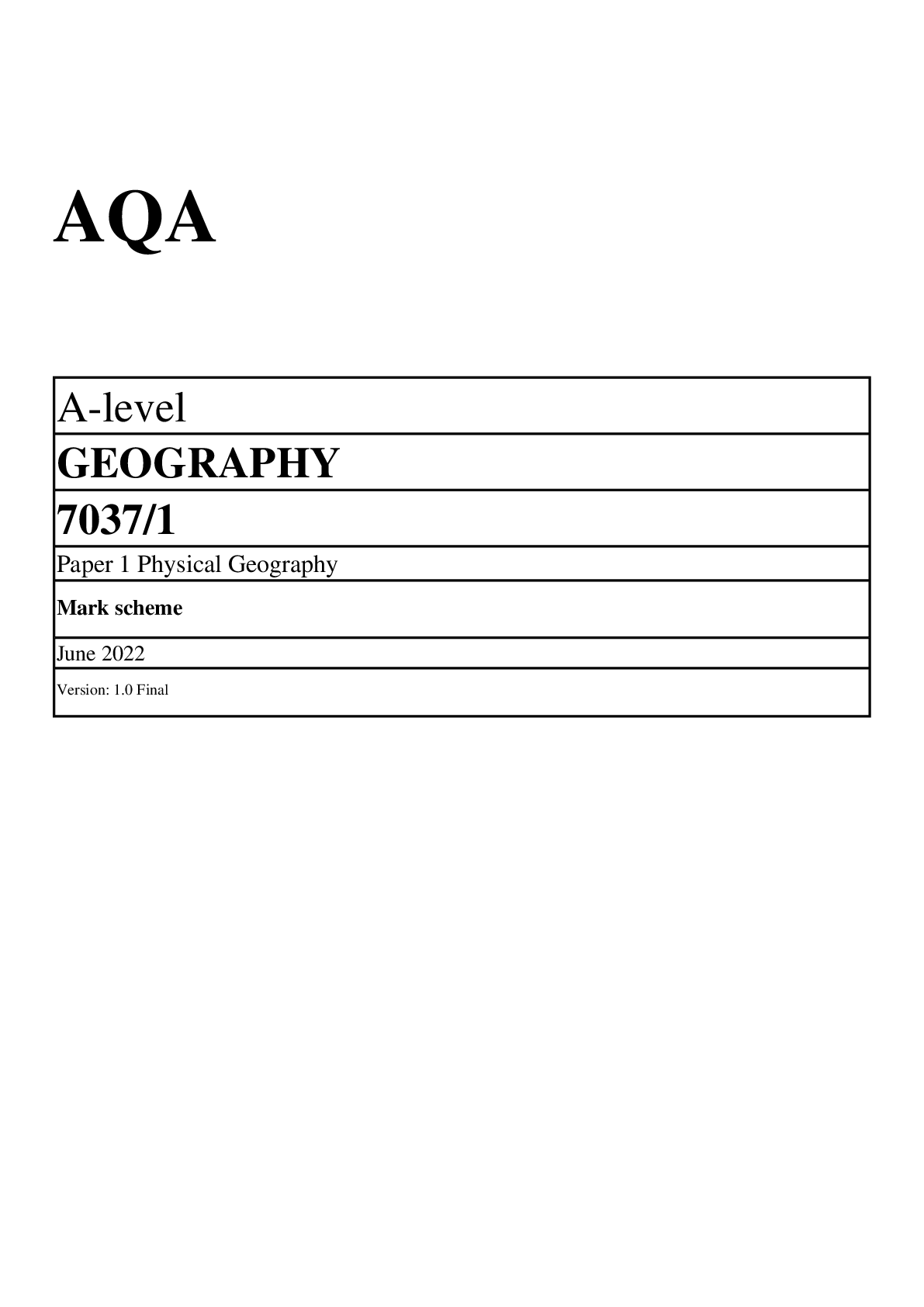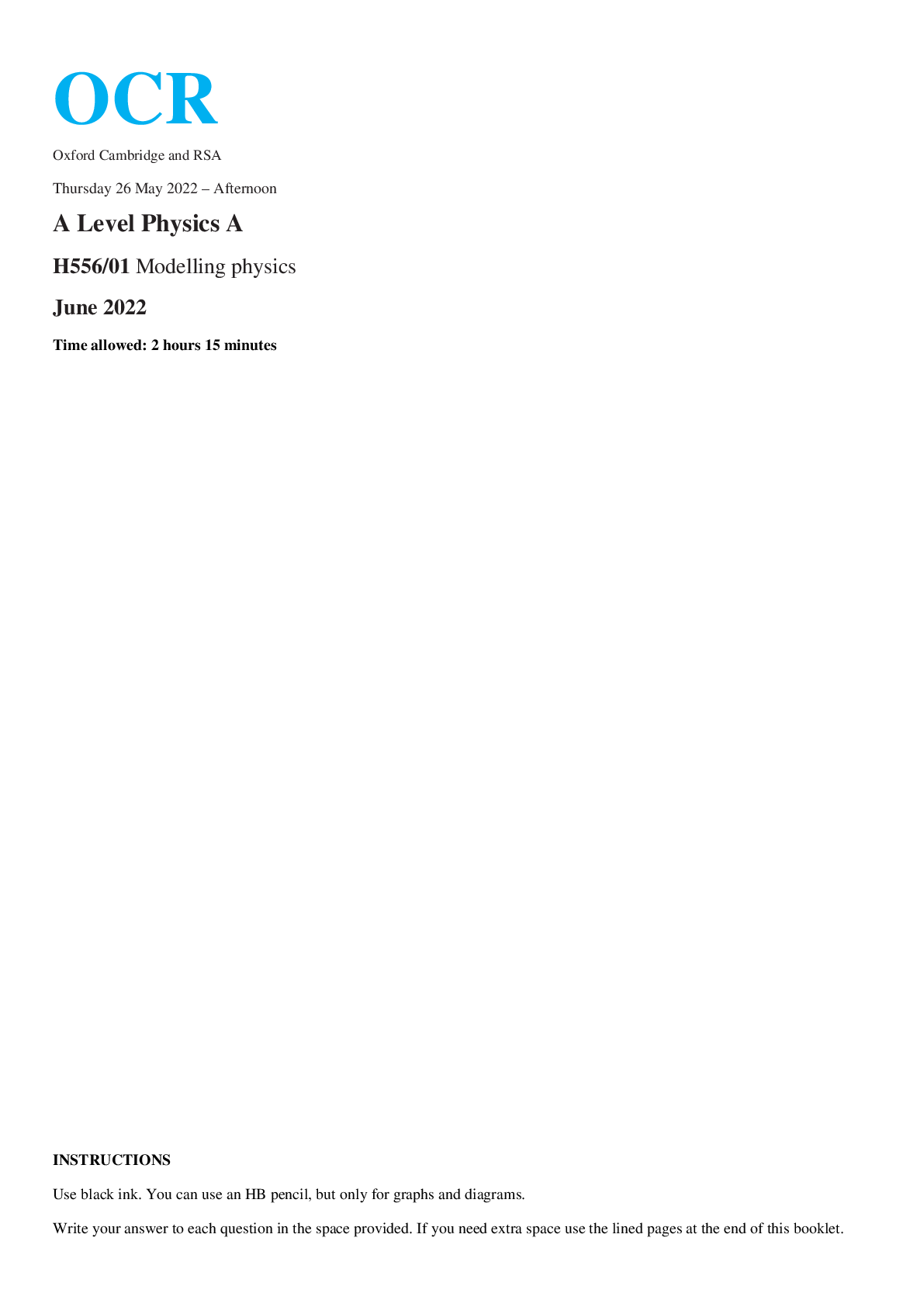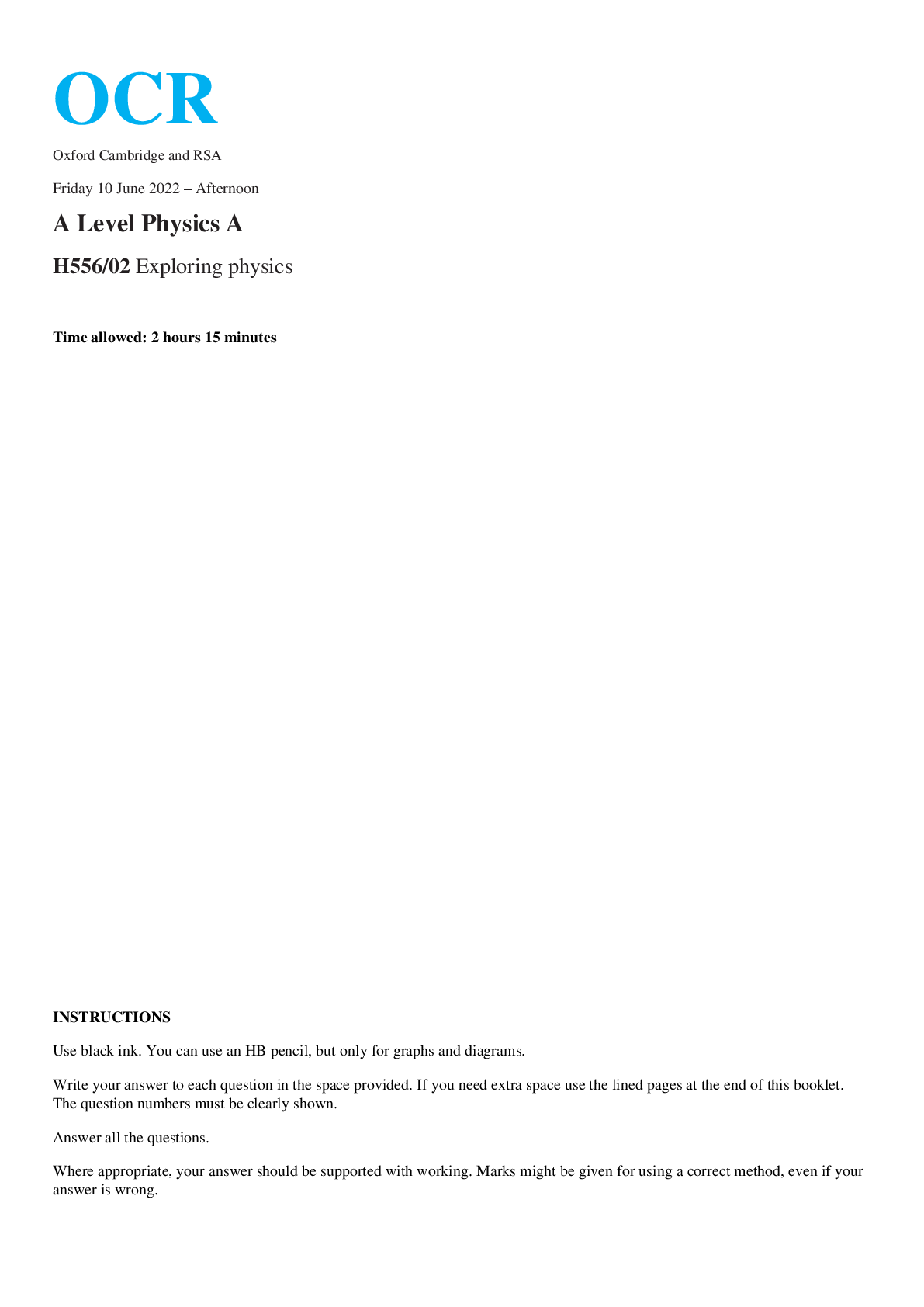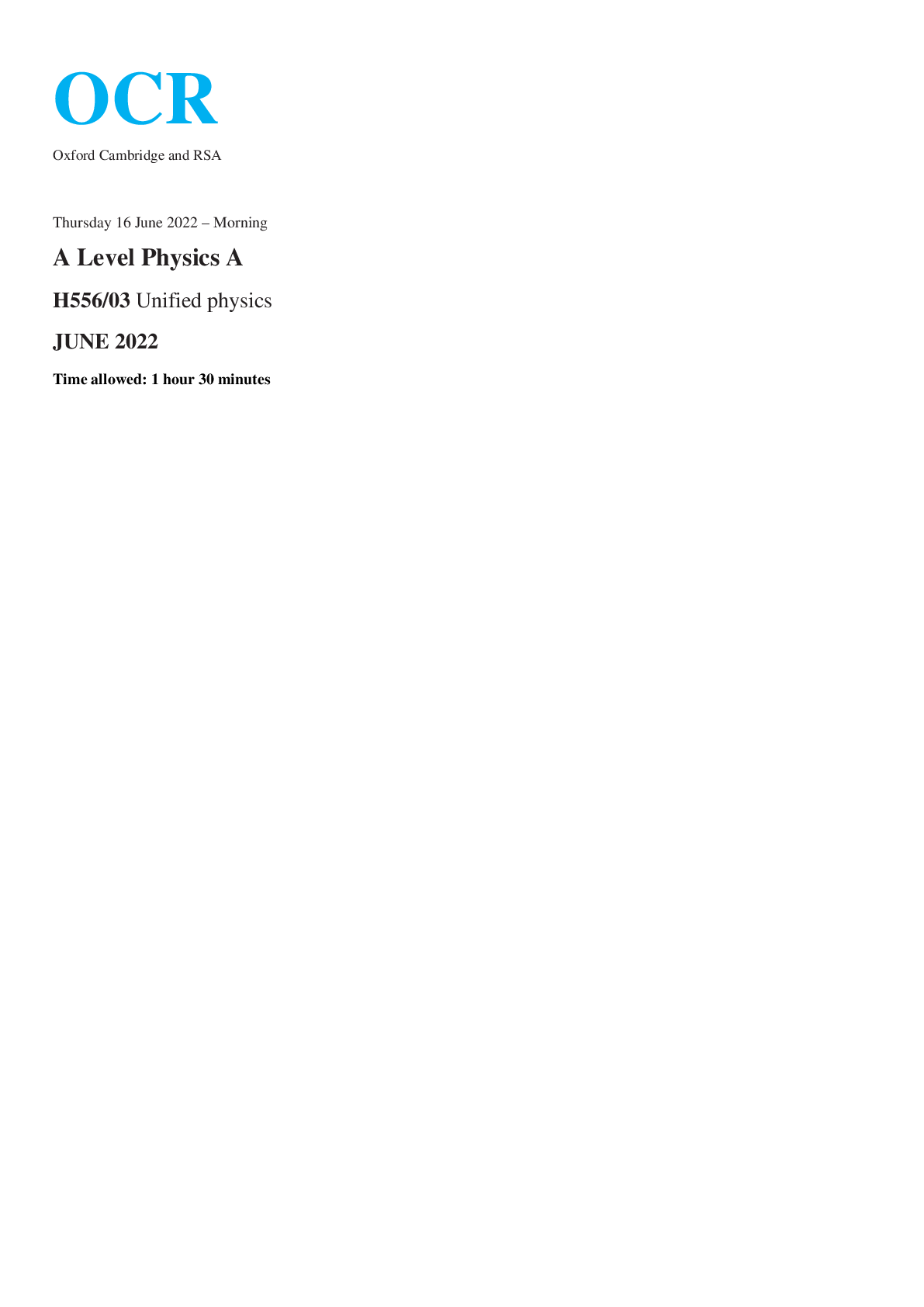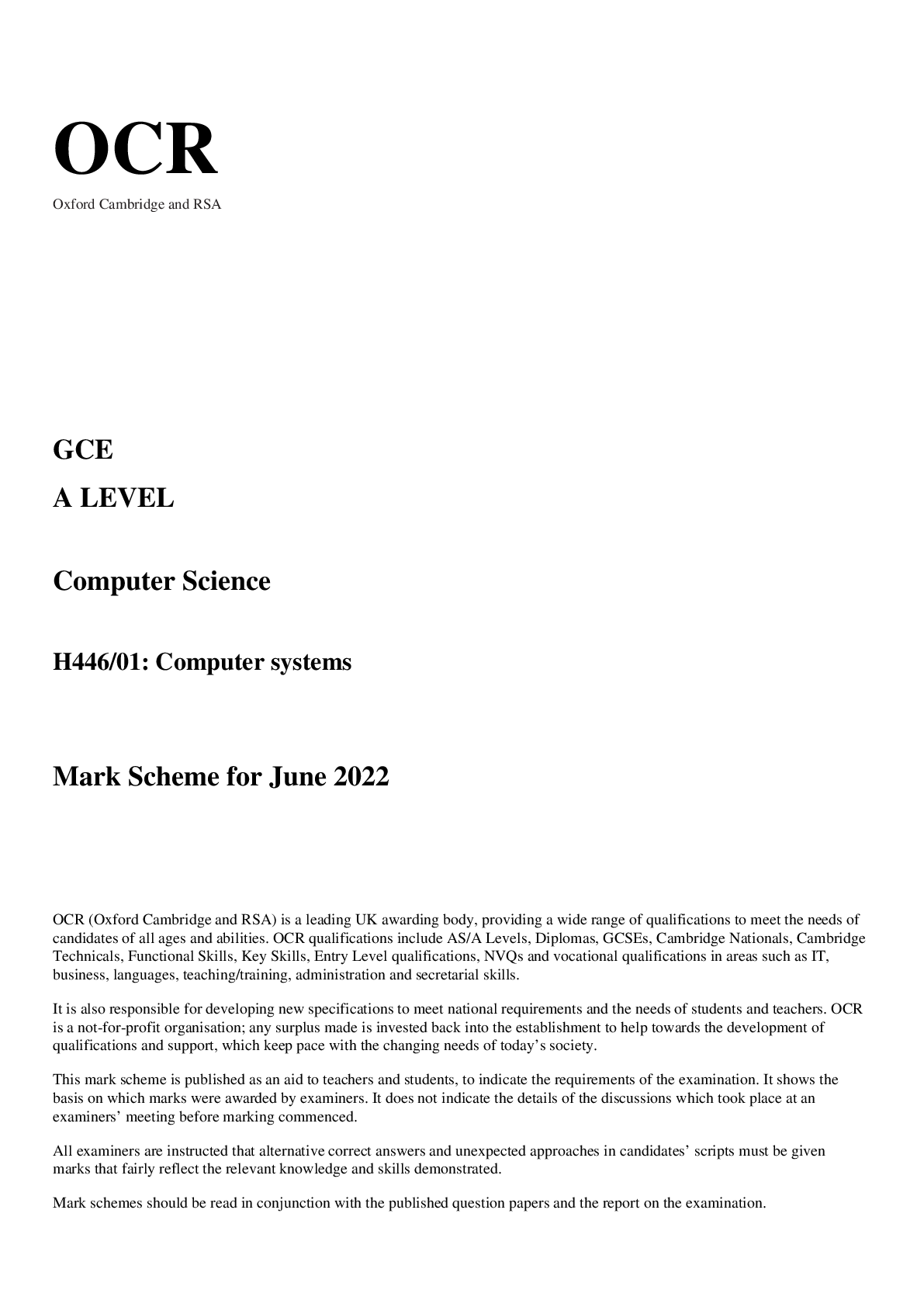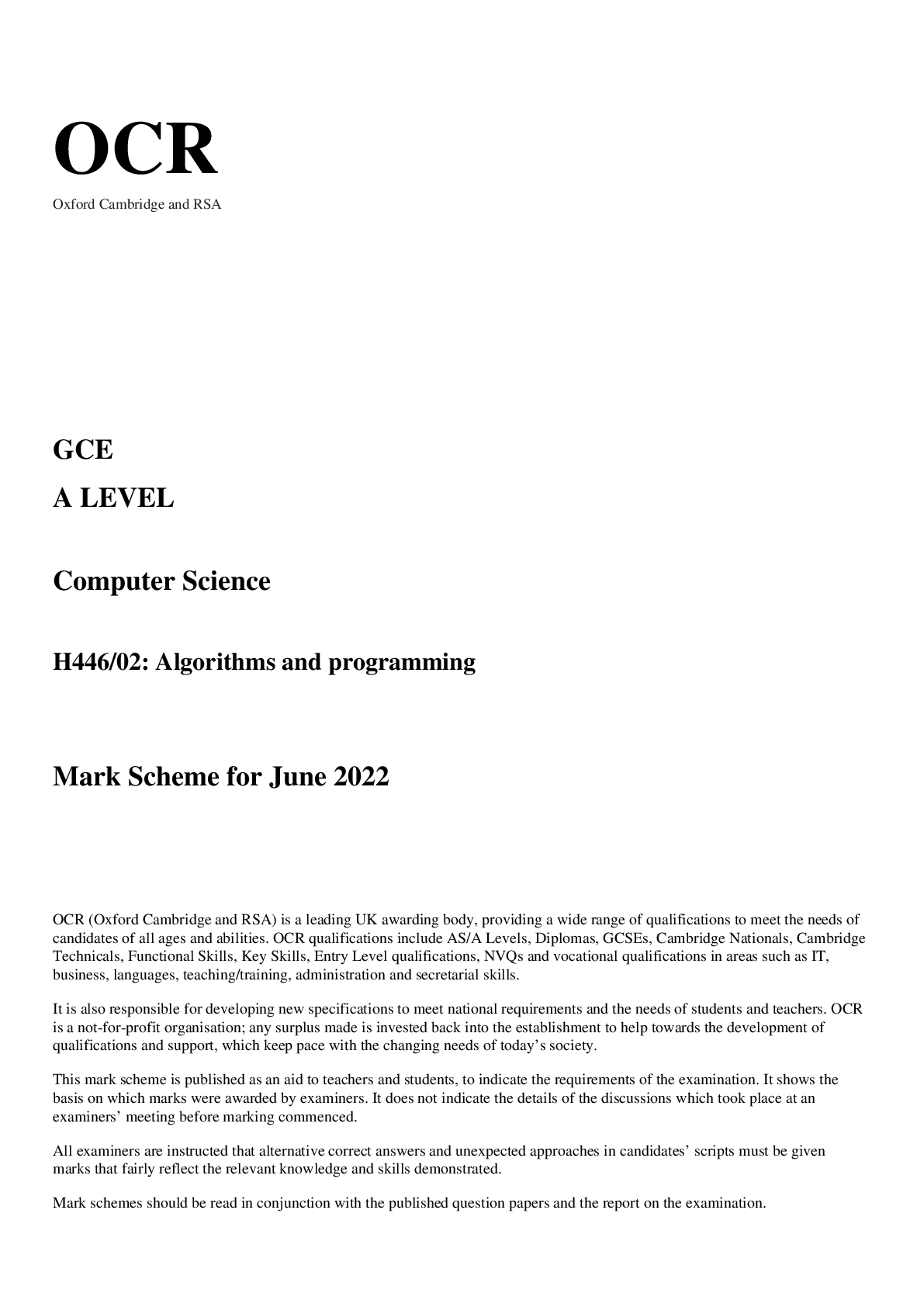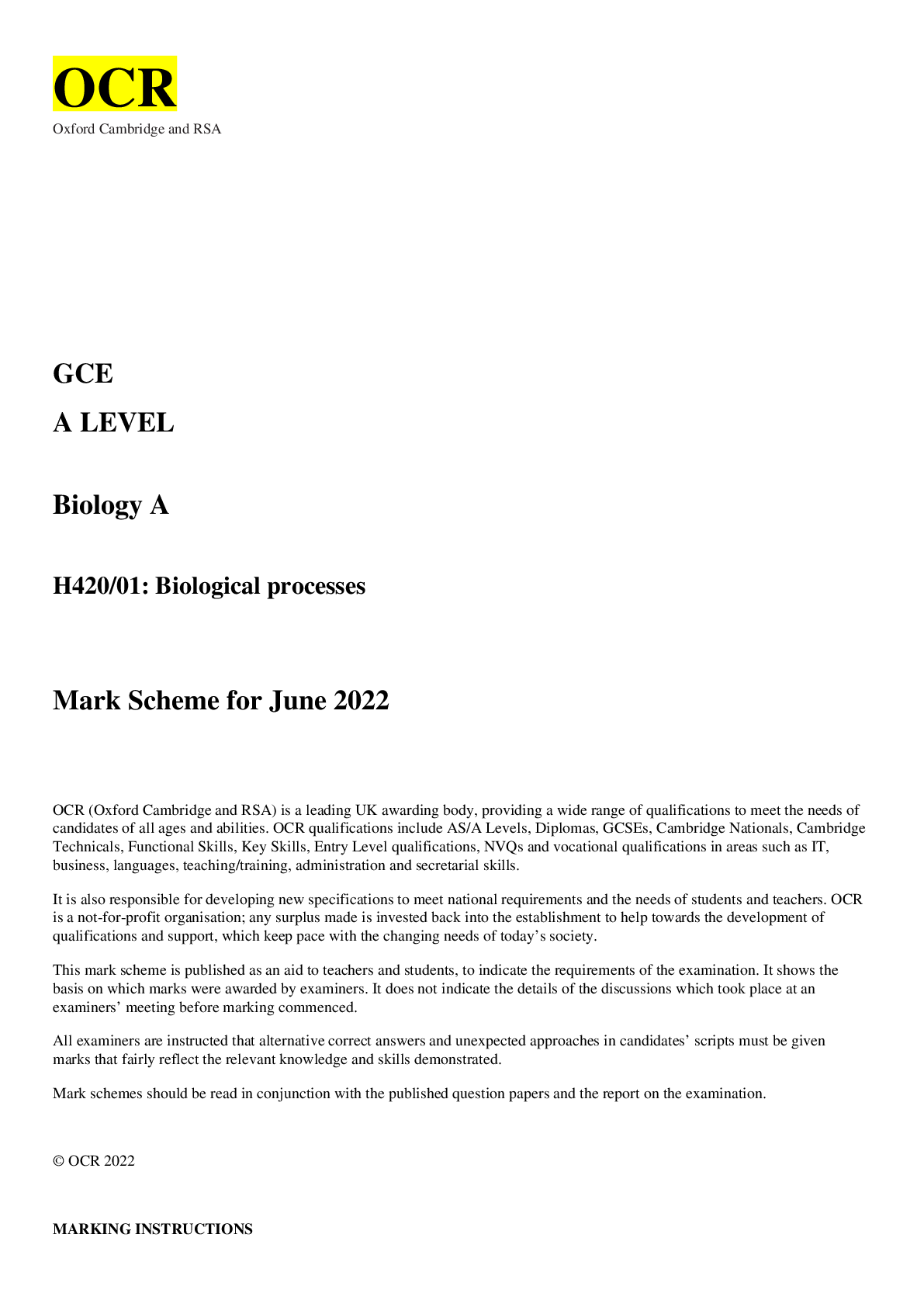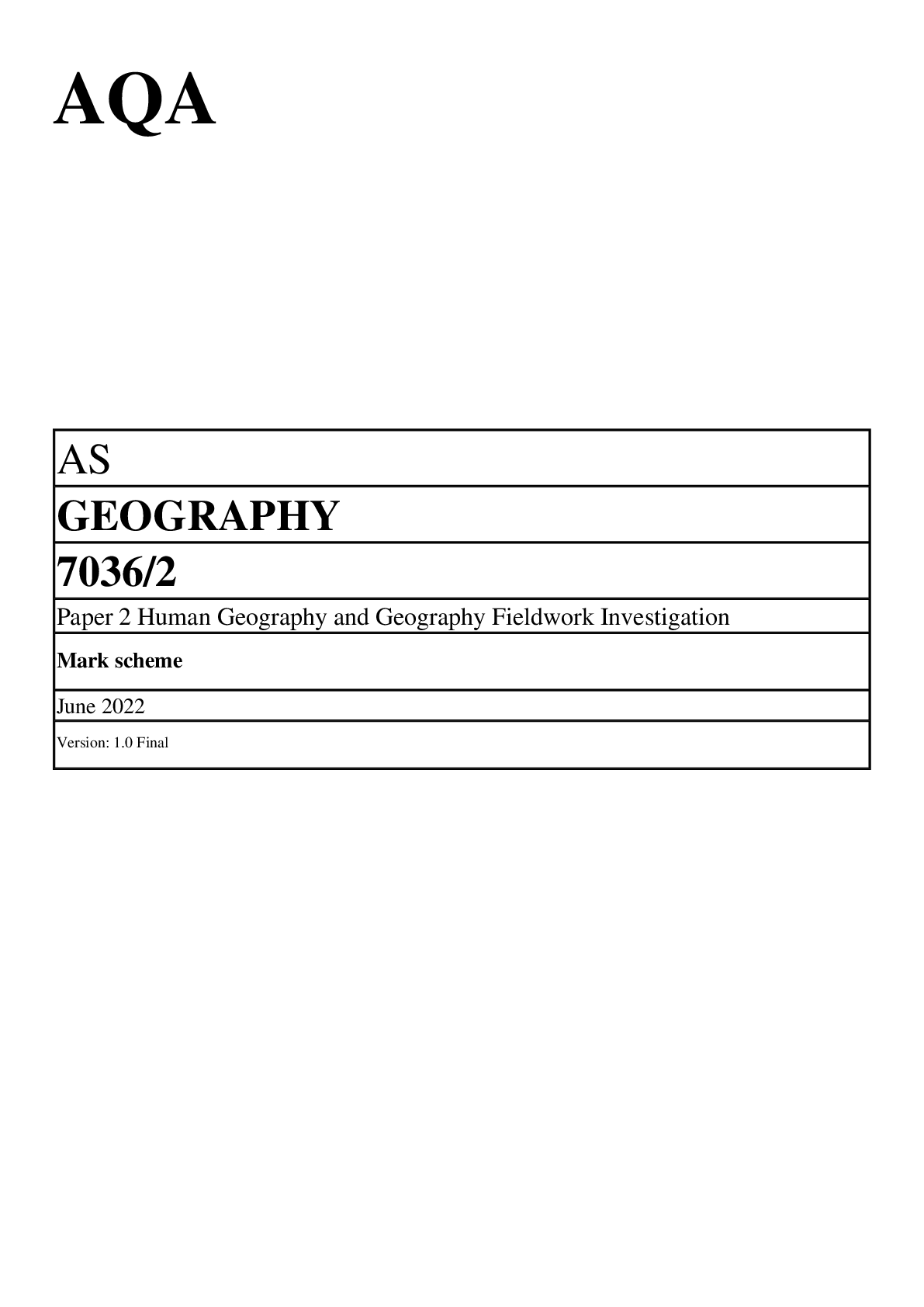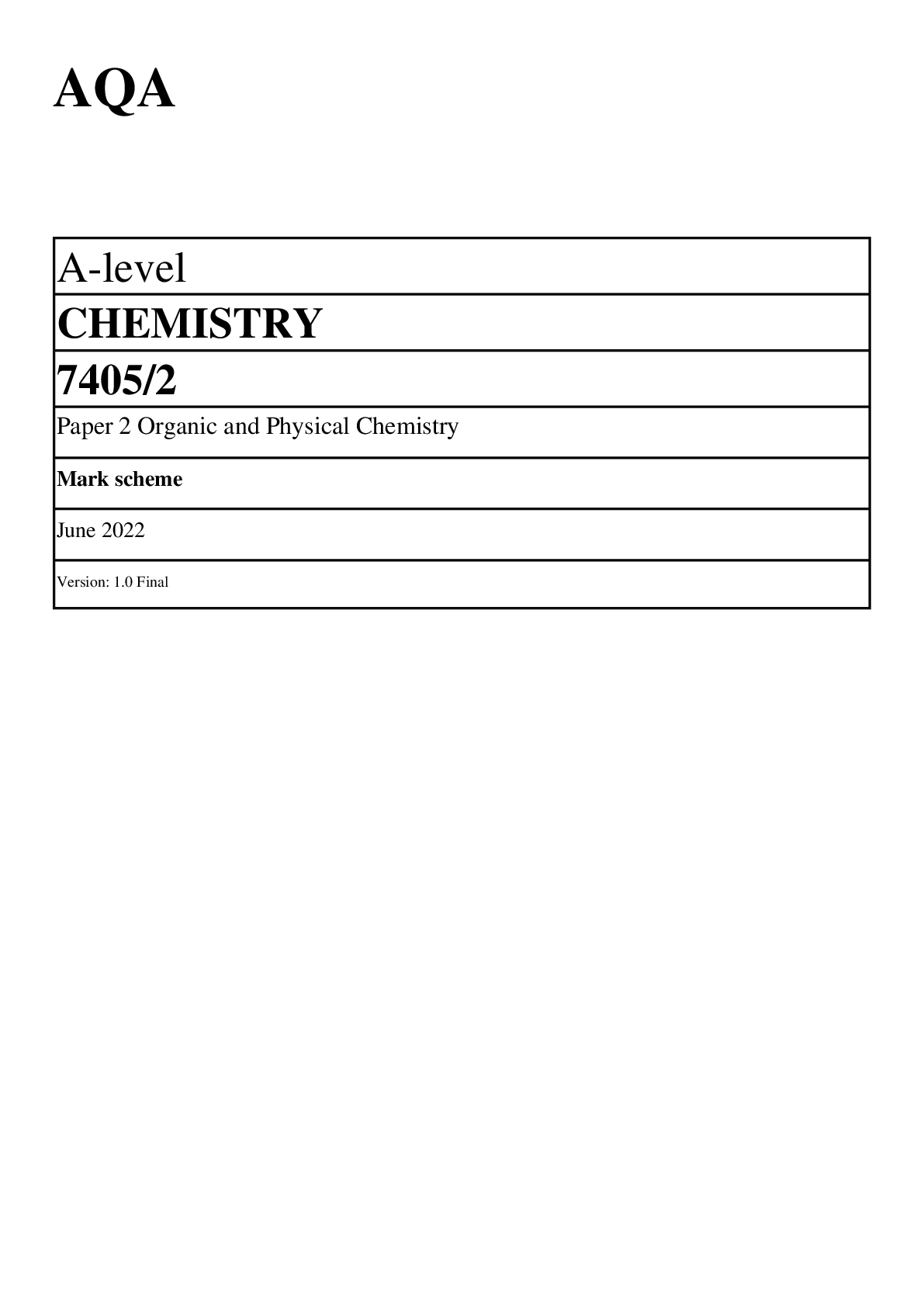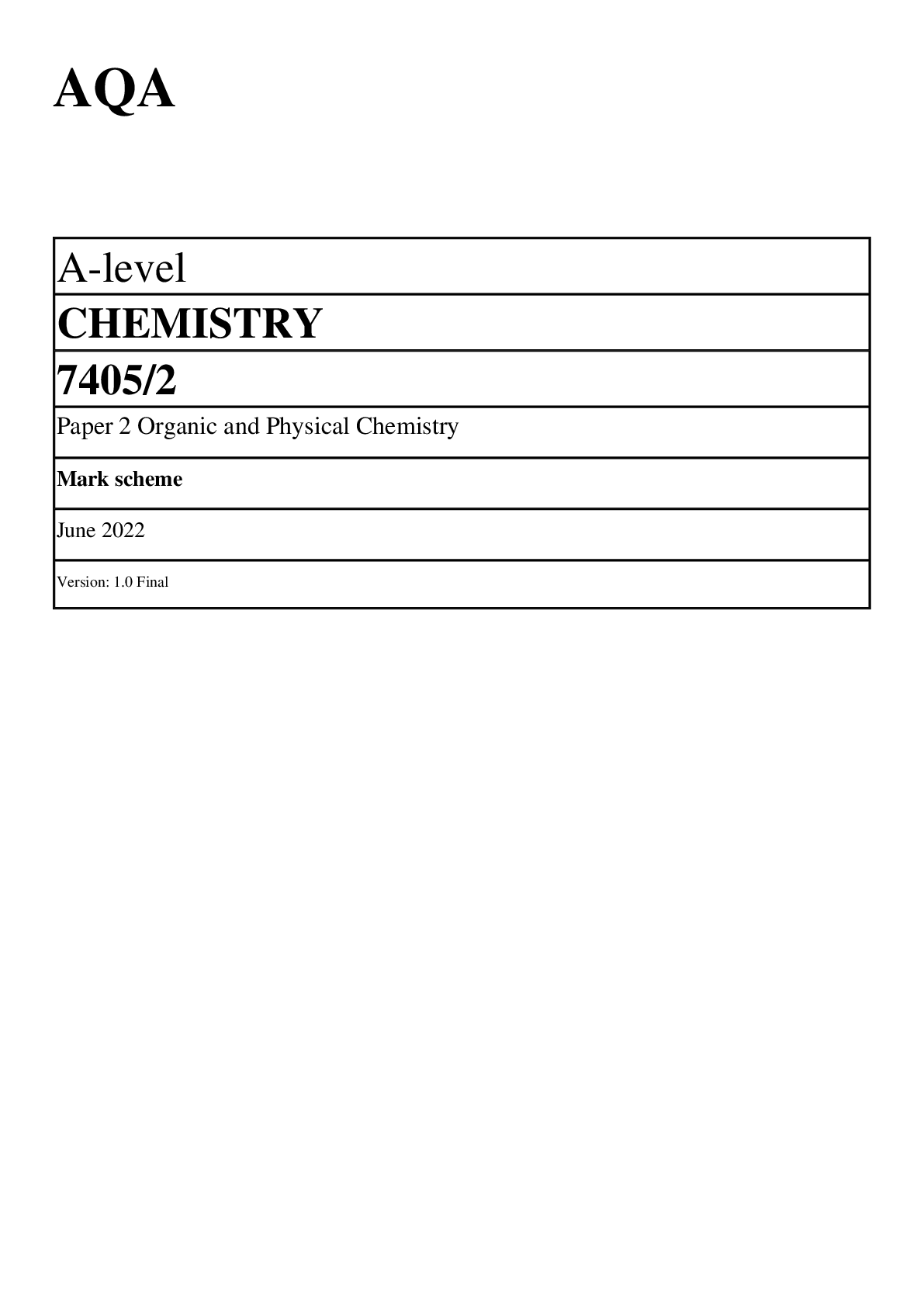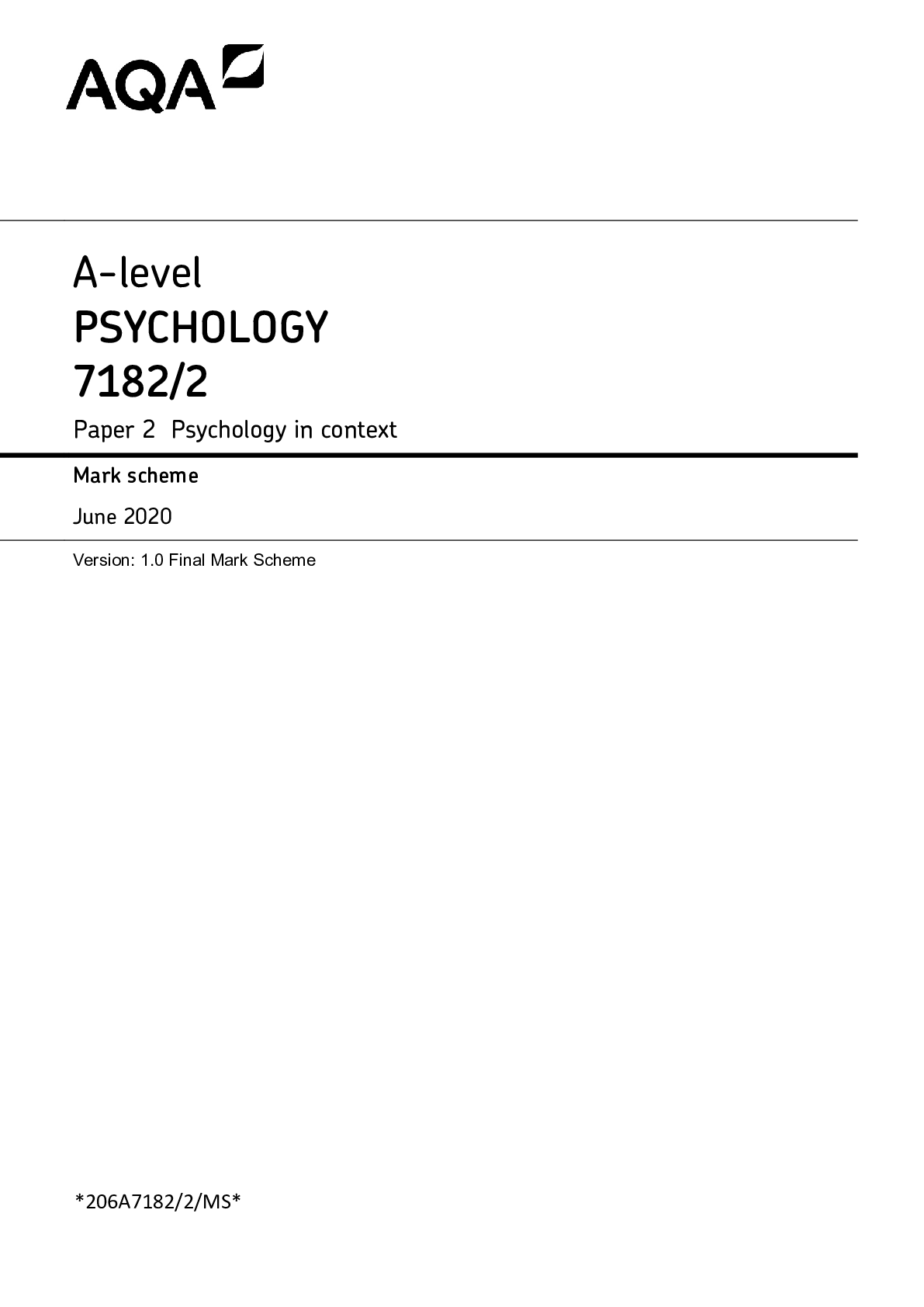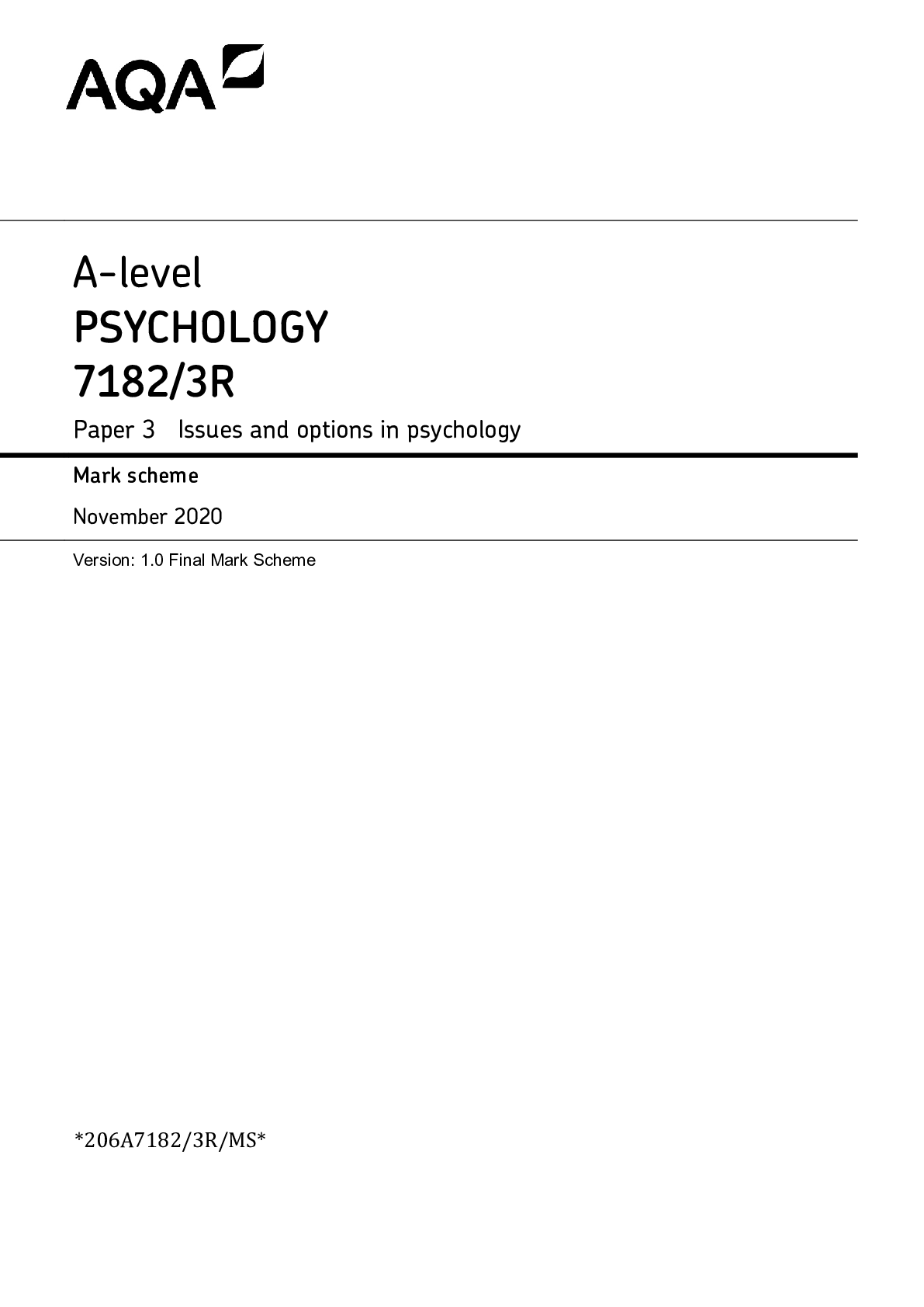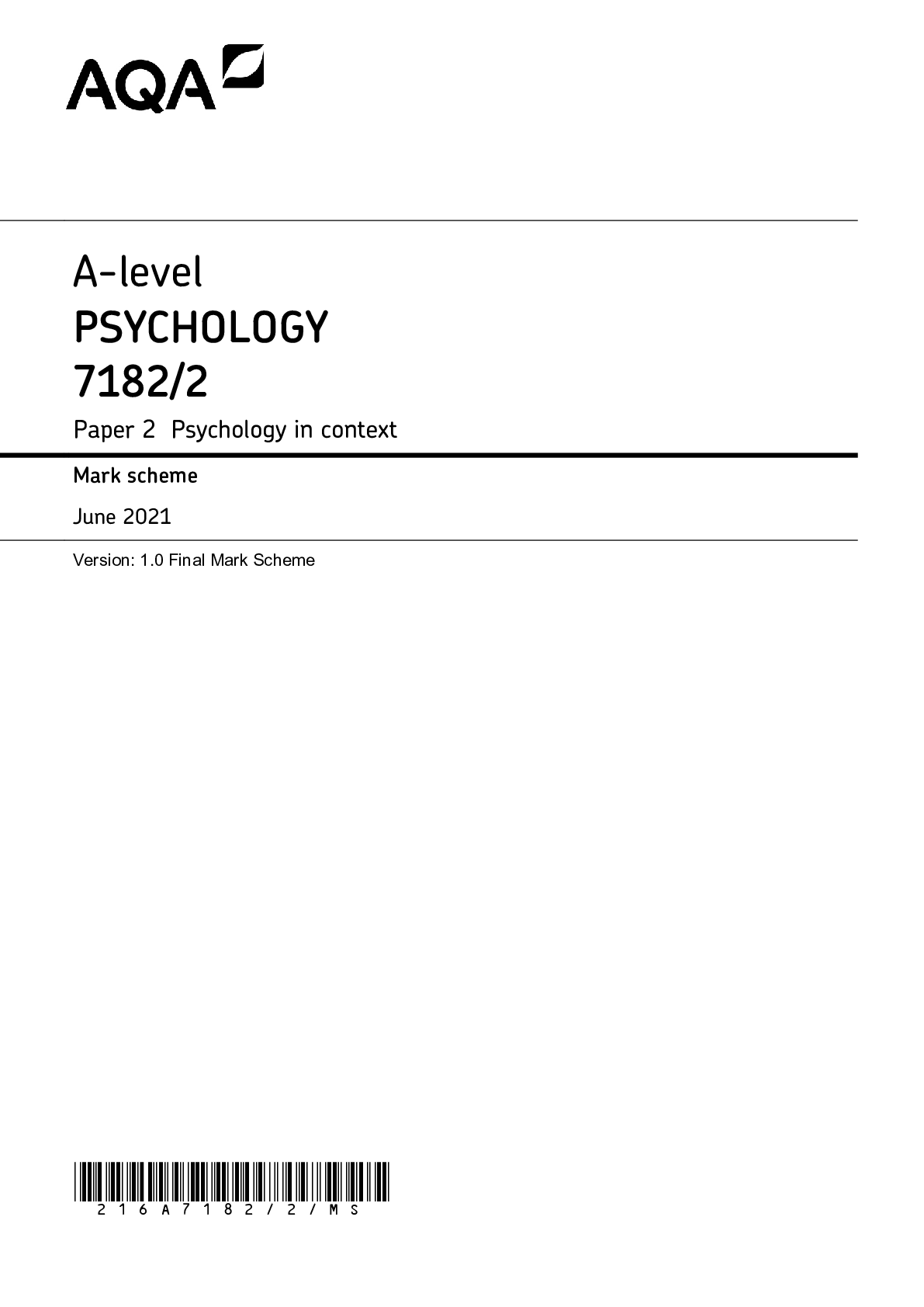OCR > A-Level Mark Scheme > OCR A LEVEL Psychology H567/03: Applied psychology Mark Scheme June 2022 (All)
OCR A LEVEL Psychology H567/03: Applied psychology Mark Scheme June 2022
Document Content and Description Below
A LEVEL Psychology H567/03: Applied psychology Mark Scheme June 2022 OCR (Oxford Cambridge and RSA) is a leading UK awarding body, providing a wide range of qualifications to meet th... e needs of candidates of all ages and abilities. OCR qualifications include AS/A Levels, Diplomas, GCSEs, Cambridge Nationals, Cambridge Technicals, Functional Skills, Key Skills, Entry Level qualifications, NVQs and vocational qualifications in areas such as IT, business, languages, teaching/training, administration and secretarial skills. It is also responsible for developing new specifications to meet national requirements and the needs of students and teachers. OCR is a not-for-profit organisation; any surplus made is invested back into the establishment to help towards the development of qualifications and support, which keep pace with the changing needs of today’s society. This mark scheme is published as an aid to teachers and students, to indicate the requirements of the examination. It shows the basis on which marks were awarded by examiners. It does not indicate the details of the discussions which took place at an examiners’ meeting before marking commenced. All examiners are instructed that alternative correct answers and unexpected approaches in candidates’ scripts must be given marks that fairly reflect the relevant knowledge and skills demonstrated. Mark schemes should be read in conjunction with the published question papers and the report on the examination. © OCR 2022 MARKING INSTRUCTIONS PREPARATION FOR MARKING RMASSESSOR3 1. Make sure that you have accessed and completed the relevant training packages for on-screen marking: RMAssessor3 assessor Online Training; OCR Essential Guide to Marking. 2. Make sure that you have read and understood the mark scheme and the question paper for this unit. These are posted on the RM Cambridge Assessment Support Portal 3. Log-in to RMAssessor3 and mark the required number of practice responses (“scripts”) and the required number of standardisation responses. YOU MUST MARK 10 PRACTICE AND 10 STANDARDISATION RESPONSES BEFORE YOU CAN BE APPROVED TO MARK LIVE SCRIPTS. MARKING 1. Mark strictly to the mark scheme. 2. Marks awarded must relate directly to the marking criteria. 3. The schedule of dates is very important. It is essential that you meet the Assessor3 50% and 100% (traditional 40% Batch 1 and 100% Batch 2) deadlines. If you experience problems, you must contact your Team Leader (Supervisor) without delay. 4. If you are in any doubt about applying the mark scheme, consult your Team Leader by telephone or the Assessor3 messaging system, or by email. 5. Crossed Out Responses Where a candidate has crossed out a response and provided a clear alternative then the crossed out response is not marked. Where no alternative response has been provided, examiners may give candidates the benefit of the doubt and mark the crossed out response where legible. Rubric Error Responses – Optional Questions Where candidates have a choice of question across a whole paper or a whole section and have provided more answers than required, then all responses are marked and the highest mark allowable within the rubric is given. Enter a mark for each question answered into RM assessor, which will select the highest mark from those awarded. (The underlying assumption is that the candidate has penalised themselves by attempting more questions than necessary in the time allowed.) Contradictory Responses When a candidate provides contradictory responses, then no mark should be awarded, even if one of the answers is correct. Short Answer Questions (requiring only a list by way of a response, usually worth only one mark per response) Where candidates are required to provide a set number of short answer responses then only the set number of responses should be marked. The response space should be marked from left to right on each line and then line by line until the required number of responses have been considered. The remaining responses should not then be marked. Examiners will have to apply judgement as to whether a ‘second response’ on a line is a development of the ‘first response’, rather than a separate, discrete response. (The underlying assumption is that the candidate is attempting to hedge their bets and therefore getting undue benefit rather than engaging with the question and giving the most relevant/correct responses.) Short Answer Questions (requiring a more developed response, worth two or more marks) If the candidates are required to provide a description of, say, three items or factors and four items or factors are provided, then mark on a similar basis – that is downwards (as it is unlikely in this situation that a candidate will provide more than one response in each section of the response space.) Longer Answer Questions (requiring a developed response) Where candidates have provided two (or more) responses to a medium or high tariff question which only required a single (developed) response and not crossed out the first response, then only the first response should be marked. Examiners will need to apply professional judgement as to whether the second (or a subsequent) response is a ‘new start’ or simply a poorly expressed continuation of the first response. 6. Always check the pages (and additional objects if present) at the end of the response in case any answers have been continued there. If the candidate has continued an answer there then add a tick to confirm that the work has been seen. 7. Award No Response (NR) if: • there is nothing written in the answer space. Award Zero ‘0’ if: • anything is written in the answer space and is not worthy of credit (this includes text and symbols). Team Leaders must confirm the correct use of the NR button with their markers before live marking commences and should check this when reviewing scripts. 8. The Assessor3 comments box is used by your team leader to explain the marking of the practice responses. Please refer to these comments when checking your practice responses. Do not use the comments box for any other reason. If you have any questions or comments for your team leader, use the phone, the Assessor3 messaging system, or e-mail. 9. Assistant Examiners will send a brief report on the performance of candidates to their Team Leader (Supervisor) via email by the end of the marking period. The report should contain notes on particular strengths displayed as well as common errors or weaknesses. Constructive criticism of the question paper/mark scheme is also appreciated. 10. For answers marked by levels of response: a. To determine the level – start at the highest level and work down until you reach the level that matches the answer b. To determine the mark within the level, consider the following: Descriptor Award mark On the borderline of this level and the one below At bottom of level Just enough achievement on balance for this level Above bottom and either below middle or at middle of level (depending on number of marks available) Meets the criteria but with some slight inconsistency Above middle and either below top of level or at middle of level (depending on number of marks available) Consistently meets the criteria for this level At top of level 1. Subject-specific Marking Instructions INTRODUCTION Your first task as an Examiner is to become thoroughly familiar with the material on which the examination depends. This material includes: • the specification, especially the assessment objectives • the question paper and its rubrics • the mark scheme. You should ensure that you have copies of these materials. You should ensure also that you are familiar with the administrative procedures related to the marking process. These are set out in the OCR booklet Instructions for Examiners. If you are examining for the first time, please read carefully Appendix 5 Introduction to Script Marking: Notes for New Examiners. Please ask for help or guidance whenever you need it. Your first point of contact is your Team Leader. LEVELS OF RESPONSE – LEVEL DESCRIPTORS AO1 AO2 AO3 Good Response demonstrates good relevant knowledge and understanding. Accurate and detailed description. Response demonstrates good application of psychological knowledge and understanding. Application will be mainly explicit, accurate and relevant. Response demonstrates good analysis, interpretation and/or evaluation that is mainly relevant to the demand of the question. Valid conclusions that effectively summarise issues and argument is highly skilled and shows good understanding. Reasonable Response demonstrates reasonable relevant knowledge and understanding. Generally accurate description lacking some detail. Response demonstrates reasonable application of psychological knowledge and understanding. Application will be partially explicit, accurate and relevant. Response demonstrates reasonable analysis, interpretation and/or evaluation that is partially relevant to the demand of the question. Valid conclusions that effectively summarise issues and argument are competent and understanding is reasonable. Limited Response demonstrates limited relevant knowledge and understanding. Limited description lacking in detail. Response demonstrates limited application of psychological knowledge and understanding. Application may be related to the general topic area rather than the specific question. Response demonstrates limited analysis, interpretation and/or evaluation that may be related to topic area. Some valid conclusions that summarise issues and arguments. Basic Response demonstrates basic knowledge and understanding that is only partially relevant. Basic description with no detail. Response demonstrates basic application of psychological knowledge and understanding. Responses will be generalised lacking focus on the question. Response demonstrates basic analysis, interpretation and/or evaluation that is not related to the question. Basic or no valid conclusions that attempt to summarise issues. No evidence of arguments. USING THE MARK SCHEME Please study this Mark Scheme carefully. The Mark Scheme is an integral part of the process that begins with the setting of the question paper and ends with the awarding of grades. Question papers and Mark Schemes are developed in association with each other so that issues of differentiation and positive achievement can be addressed from the very start. This Mark Scheme is a working document; it is not exhaustive; it does not provide ‘correct’ answers. The Mark Scheme can only provide ‘best guesses’ about how the question will work out, and it is subject to revision after we have looked at a wide range of scripts. In your marking, you will encounter valid responses which are not covered by the Mark Scheme: these responses must be credited. You will encounter answers which fall outside the ‘target range’ of Bands for the paper which you are marking. Please mark these answers according to the marking criteria. Please read carefully all the scripts in your allocation and make every effort to look positively for achievement throughout the ability range. Always be prepared to use the full range of marks. INSTRUCTIONS TO EXAMINERS: INDIVIDUAL ANSWERS 1 The indicative content indicates the expected parameters for candidates’ answers, but be prepared to recognise and credit unexpected approaches where they show relevance. 2 Using ‘best-fit’, decide first which set of BAND DESCRIPTORS best describes the overall quality of the answer. Once the band is located, adjust the mark concentrating on features of the answer which make it stronger or weaker following the guidelines for refinement. Highest mark: If clear evidence of all the qualities in the band descriptors is shown, the HIGHEST Mark should be awarded. Lowest mark: If the answer shows the candidate to be borderline (i.e. they have achieved all the qualities of the bands below and show limited evidence of meeting the criteria of the band in question) the LOWEST mark should be awarded. Middle mark: This mark should be used for candidates who are secure in the band. They are not ‘borderline’ but they have only achieved some of the qualities in the band descriptors. 3 Be prepared to use the full range of marks. Do not reserve (e.g.) high Band 6 marks ‘in case’ something turns up of a quality you have not yet seen. If an answer gives clear evidence of the qualities described in the band descriptors, reward appropriately. 4 Consideration should be given to the weightings of the assessment objectives within a question, these are clearly stated for each question and care should be taken not to place too much emphasis on a particular skill. Section A: Issues in mental health Question Answer Marks Guidance 1 (a) Outline one similarity between two historical views of mental illness. AO1 (2 marks) Candidates will display knowledge and understanding through accurate reference to historical views of mental illness in support of their point of comparison. Examples of creditworthy historical views of mental illness include demonic possession (treated through trepanning), witchcraft, an imbalance in the four humours (including reference to elements, seasons and/or temperature), moral treatment, etc., up to and including the psychodynamic perspective, the anti-psychiatry movement, and even abnormal levels of neurotransmitters. As a rule of thumb, anything that originated in the 1960s or earlier can be treated as historical. AO3 (1 mark) The similarity could be based around debates (e.g. psychology as a science; reductionism/holism; freewill/determinism; ethical considerations); however, other points of comparison are also creditworthy (e.g. the approach to psychology that the historical views reflect; having similar causes; leading to similar treatments). Historical views of mental illness can relate to explanations and/or treatments. The similarity should be clearly identified, and linked to two historical views of mental illness. 3 3 marks – Good comparison. Similarity between historical views of mental illness is identified (1), and supported by relevant evidence from two historical views of mental illness (1+1). 2 marks – Reasonable comparison. Similarity between historical views of mental illness is identified (1), and supported by relevant evidence from one historical view of mental illness (1). 1 mark – Limited comparison. Similarity between historical views of mental illness is identified (1), but not supported by any relevant evidence from historical views of mental illness, or evidence of a historical view is outlined but no (defensible) similarity to another historical view is advanced. 0 marks – No creditworthy response NB If more than one similarity is outlined, then it is the first that should be credited. [Show More]
Last updated: 2 years ago
Preview 1 out of 24 pages

Buy this document to get the full access instantly
Instant Download Access after purchase
Buy NowInstant download
We Accept:

Reviews( 0 )
$17.00
Can't find what you want? Try our AI powered Search
Document information
Connected school, study & course
About the document
Uploaded On
May 18, 2023
Number of pages
24
Written in
Additional information
This document has been written for:
Uploaded
May 18, 2023
Downloads
0
Views
164

